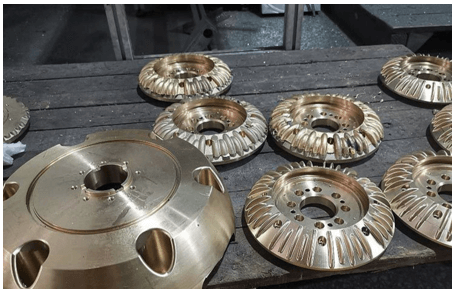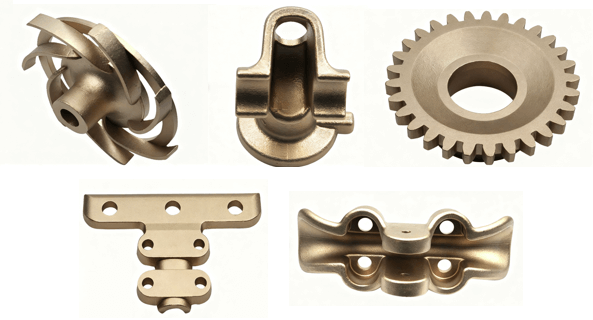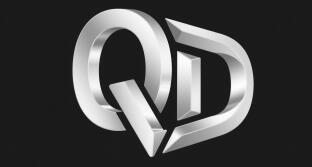Ordinary tin bronze lacks sufficient strength for high-load applications. When you need better corrosion resistance and wear resistance, choose aluminum bronze. It is the ideal choice for many industrial applications. QD is a manufacturer of aluminum bronze castings.

What is Aluminum Bronze?
Aluminum bronze is a copper-based alloy. Its main alloying element is aluminum (typically 5% to 12%). It may also contain iron, nickel, manganese and other elements.
In its microstructure, aluminum bronze usually contains α phase (copper-rich) and β phase (aluminum-rich). It combines high strength, good wear resistance, and excellent corrosion resistance. It is suitable for use in demanding conditions.
| Composition/Property | Description |
| Main Elements | Copper (base), Aluminum (5%-12%), Iron (≤5%), Nickel (≤2%), etc. |
| Density | ~7.5 g/cm³. Lighter than many steel alloys. |
| Tensile Strength | 500-1000 MPa. Comparable to medium-low strength steel. |
| Hardness | 150-250 HB. Can be adjusted through heat treatment. |
| Corrosion Resistance | Excellent, especially in seawater, acidic, and alkaline environments. |
| Wear Resistance | Very high. |
QD has extensive experience in producing aluminum bronze castings. We can produce high-precision components to your specifications.
Main Differences Between Aluminum Bronze and Tin Bronze
Tin bronze (primarily copper-tin alloy). It offers good castability and lower cost. However, aluminum bronze often holds more advantages in demanding applications:
Higher Strength
Aluminum bronze has significantly higher tensile strength, yield strength, and impact toughness than tin bronze. Its mechanical properties are close to those of steel. Some aluminum bronze grades can achieve tensile strengths up to 1000 MPa, while typical tin bronze is usually only 200-400 MPa. This allows aluminum bronze to withstand higher dynamic loads and impact, making it suitable for heavy-duty structural parts.
Better Wear Resistance
Aluminum bronze performs exceptionally well under sliding and rolling contact conditions. This is due to its hard phases (like kappa phase) and self-lubricating properties. In contrast, tin bronze tends to wear excessively in high-speed or high-load environments. For example, in mining machinery or heavy-duty bearings, aluminum bronze parts often last several times longer than tin bronze.
Excellent Corrosion Resistance
Aluminum bronze shows strong corrosion resistance in both oxidizing and reducing environments (like sulfuric acid and alkaline solutions). Its surface forms a dense aluminum oxide film that prevents further corrosion. In comparison, tin bronze may suffer from selective leaching (dezincification) in acidic or fast-flowing seawater.
| Performance Indicator | Aluminum Bronze | Tin Bronze |
| Tensile Strength | 500-1000 MPa | 200-400 MPa |
| Hardness (HB) | 150-250 | 60-120 |
| Wear Resistance | Very high, suitable for high-load wear environments | Medium, suitable for low-speed light-load environments |
| Seawater Corrosion Resistance | Excellent, protected by oxide film | Average, prone to pitting corrosion |
| Cost | Relatively high | Relatively low |
| Typical Applications | Heavy-duty gears, marine components, chemical equipment | General bearings, art castings, low-pressure valves |

Core Advantages of Aluminum Bronze
Balanced Strength and Toughness: High strength-to-weight ratio. Good toughness and fatigue resistance. Suitable for dynamic load equipment.
Excellent Corrosion Resistance: Works reliably long-term in chemical media. For example, its corrosion rate is much lower than other copper alloys across a wide pH range.
Superior Wear and Galling Resistance: Resists galling when paired with steel in bearing and gear applications. Reduces maintenance needs.
Safety Feature: Aluminum bronze tools do not generate sparks upon impact. Therefore, they are widely used in flammable and explosive environments like oil and gas.
Sustainability: Recyclable, aligns with environmental trends. Long service life lowers total lifecycle cost.
These advantages improve equipment reliability and reduce total ownership cost. QD helps clients maximize these benefits.
Typical Application Fields of Aluminum Bronze
Heavy-Duty Bearings and Gears
Used in mining machinery, heavy machine tools, and power generation equipment. Aluminum bronze bearings and gears withstand high loads, impact, and vibration. Their wear resistance and anti-galling properties extend component service life and reduce downtime.
Marine and Chemical Engineering
Widely used in ship components (e.g., propellers, steering gears, seawater pumps) and chemical equipment (e.g., valves, heat exchangers, agitators). It ensures long-term reliable operation in harsh environments.
Tools and Safety Equipment
Applied in petroleum, chemical, and military industries for non-sparking tools (e.g., wrenches, hammers) to prevent ignition of flammable gases. Also suitable for mold and fixture components.
Other Applications
Aerospace: Landing gear components and engine parts.
Power industry: Conductive components and connectors.
General machinery: Pump housings, sealing rings, etc.

Why Choose QD Aluminum Bronze?
When selecting materials, you must consider the working conditions, cost-effectiveness, and long-term performance. Although aluminum bronze has a higher initial cost, its long service life, low maintenance, and high reliability often result in a better total cost of ownership. The following key points aid decision-making:
- Matching Working Conditions: If your application involves high loads, corrosive media, or abrasive environments, aluminum bronze is the ideal choice.
- Performance Verification: Lab tests and field data confirm aluminum bronze performs reliably under extreme conditions.
- Customized Services: QD provides material selection, process optimization, and after-sales support to ensure castings perfectly meet your needs.
Does your application require a combination of high strength, wear resistance, and corrosion resistance? Aluminum bronze might be the solution you need. QD’s expert team can analyze your specific working conditions and recommend the most economical aluminum bronze grade and process. Contact us today
FAQ
1. Is the cost of aluminum bronze much higher than other bronzes?
Yes. The material and processing costs for aluminum bronze are typically higher than for tin bronze. However, its long service life and low maintenance reduce total cost in demanding applications. It offers better cost performance.
2. In what environments is aluminum bronze most suitable?
It is best for environments requiring a combination of high strength, high wear resistance, and corrosion resistance. Examples include marine engineering, chemical equipment, and heavy-duty machinery. For ordinary conditions, tin bronze may be more economical.
3. Is aluminum bronze difficult to cast?
Casting aluminum bronze requires controlled cooling rates and melting processes to avoid defects. QD uses advanced casting technology and quality control to ensure casting consistency and reliability.
4. How to choose between aluminum bronze and tin bronze?
Base your choice on application needs. If strength, wear resistance, or corrosion resistance are the main concerns, choose aluminum bronze. If cost is the priority and conditions are mild, tin bronze may be sufficient.
5. Does aluminum bronze require special maintenance?
Generally, aluminum bronze components require low maintenance. However, in extreme environments, regular surface inspections are recommended. QD provides maintenance guidelines and lifetime support.
6. What aluminum bronze services does QD offer?
QD provides full services from material consultation, design optimization, casting production to inspection. We have multiple successful cases of aluminum bronze castings. We ensure customers receive high-quality custom solutions.
